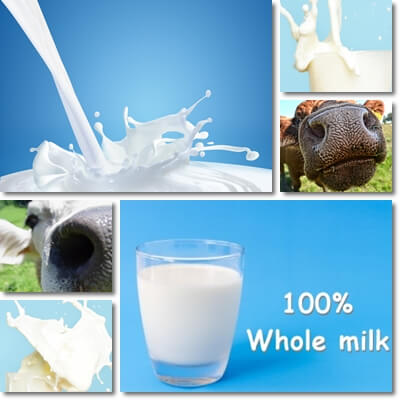What is whole milk? By definition, milk that has had nothing removed from it qualifies as whole. It may be processed to remove impurities (filtration), destroy microorganisms and increase shelf life (pasteurization) and improve taste and texture (homogenization) or improved at a nutritional scale through fortification, typically with vitamins. But in order for it to be whole, it requires no fat or other macronutrients to be removed from it. Even so, the nutritional value of whole is not consistent throughout different brands or regions.
What percent is whole milk? 6% butterfat milk is currently the highest fat content in commercial whole milk production. There’s also 5.4% butterfat, 4.8%, 4%, 3.6%, 3.5% and 3.25% whole milk. The amount of butterfat present in the milk naturally determines what percent whole milk is and explains the rather significant variations across the globe.

The truth about whole milk is that it’s never exactly the same everywhere. And its aspect of nutrition most prone to variation is its fat content. The reason why fat content varies, sometimes quite significantly, is because not all dairy cattle produce the exact same milk. Currently, the Jersey or Guernsey provide the highest butterfat milk of all commercial dairy cattle, typically over 4.8 to 5%. Then there’s also dietary and other factors which further impact fat content and other aspects of nutrition.
What does whole milk taste like?
Pasteurized, homogenized whole milk tastes delicately sweet and has a fine texture. Raw, unhomogenized milk has less of a sweet taste and its texture is not as uniform (you may taste fattier parts since butterfat tends to separate, clump together and rise to the surface). This is because the (butter)fat globules have not been broken down by homogenization (which normally helps them better disperse through the watery part of the milk and create the fine texture mouthfeel).
The top 8 most interesting nutritional facts about whole milk you should definitely know:
1) It has a lower lactose content than both low-fat and skim/non-fat. See differences between Regular, Low-Lactose and Lactose-Free Milk.
2) The higher fat content means a higher vitamin A content.
3) The fat it contains helps with the absorption of vitamins A, D, E and K (irrespective if you get them from milk or other foods you may eat with the milk).
4) It doesn’t cause weight gain, despite having more calories then low-fat or skim versions (most of the calories come from carbohydrates anyway). The effects of one food do not outweigh the effects of an entire diet (especially if that food is consumed in moderation).
5) The calcium it contains has a high bioavailability, meaning it is absorbed in a higher proportion than calcium from some vegetable sources. Getting whole milk fortified (enriched) with vitamin D further ups calcium absorption.
6) Drinking whole milk regularly reduces type 2 diabetes risks, according to researchers.
7) It contains all 9 essential amino acids the body requires to function optimally but cannot produce itself.
8) It’s a source of healthy Omega-3 and Omega-6 fatty acids.

What are the benefits of drinking whole milk regularly (and in moderation)?
1) Satiating and energizing. The higher fat and good protein property of whole milk make it a satiating food option that keeps you feeling full longer and contributes to sustained energy levels that support an active lifestyle.
2) Food for the brain. If you’re stressed, experiencing brain fog (mental confusion) or have a difficult time keeping up with studying, then a glass of whole milk might be just what your brain needs. The amino acids that make up the protein in the milk and all the fats, from Omega-3 and Omega-6 to cholesterol and saturated fats, support brain activity and especially learning and memory.
3) Good for diabetes. The good amounts of fat and protein slow down digestion and the rate of sugar absorption into the bloodstream, contributing to minimal effects on blood sugar. Even better, whole milk helps reduce the effects on blood sugar of other foods as well. For example, it’s better to have your morning cereal with some whole milk because the fat and protein in the milk will helps reduce the glycemic impact of the carbohydrates in the cereal. Also see Can Diabetics Drink Milk?
4) Strong bones and teeth. The naturally occurring calcium and magnesium and vitamin D from fortification make it a good option for strengthening bones and teeth.
5) Benefits for the cardiovascular system. Healthy Omega-3 and Omega-6 fatty acids exhibit anti-inflammatory benefits for the cardiovascular system. If consumed in moderation, the saturated fats do not raise LDL cholesterol. Lastly, magnesium and potassium hold benefits for high blood pressure.
6) Combats anemia-related fatigue and has a revitalizing effect. All thanks to generous amounts of vitamin B12 (on average, 0.45 mcg vitamin B12 in every 100 ml, which is almost 20% of the recommended daily intake for an average adult). The vitamin helps produce red blood cells which contribute to energy and vitality and helps combat fatigue. Other B vitamins (B1, B2, B3) further contribute to energy metabolism.
7) Good for pregnant women. First of all, the good amounts of vitamin B12 support the circulatory system of both mother and baby and contribute to sustained energy levels and vitality. Secondly, the vitamin helps synthesize myelin, the protective coating surrounding the tail of nerve cells and thus contributes to brain development of the baby in the womb. Omega-3 fatty acids also help with brain development of the baby.
8) Neuroprotective properties. In simpler words, whole milk protects the nervous system from degeneration. For example, both vitamin B12 and cholesterol maintain and help repair the myelin coating surrounding the tail of nerve cells, allowing them to correctly conduct electrical impulses and manage brain-body communication. The deterioration of the myelin sheath is believed to cause degenerative diseases of the nervous system such as multiple sclerosis.
9) Supports healthy vision, thanks to good amounts of vitamin A and the fat that helps us absorb it. Vitamin A further holds benefits for skin and maintains healthy mucous membranes at the level of the eyes, nose, mouth, throat, lungs and digestive system, with direct benefits for the immune system.
10) Source of zinc, phosphorus, selenium, for a more efficient immune system response, stronger bones and teeth and a healthy thyroid. Further contains trace amounts of naturally-occurring vitamin D and K and is a source of vitamin E with anti-aging benefits for skin.
Possible side effects may include the following:
1) Lactose intolerance. Although lactose content is lower than in low-fat and non-fat or skim varieties. If lactose intolerance is severe, choose lactose-free options.
2) Allergy. Some people experience an allergy to proteins in milk. Their symptoms may vary in intensity, but avoidance of milk and all products containing it is strongly advised to prevent anaphylactic shock.
3) Source of gastrointestinal infection. Usually occurs if the milk is raw (unpasteurized) and not kept in ideal refrigerator conditions at all times (also spoils fast). If you are unsure about how to handle raw milk or have never used it before, it’s safer to choose pasteurized options.
4) Thickens mucus. If you have pollen allergies or a cold or other respiratory infection, it is possible drinking milk will thicken nose and throat mucus and make it harder to eliminate. Also see White Mucus in Nose and Throat: Causes and Treatment.
Conclusion:
Given consumption is moderate and assuming one’s diet is varied and balanced, according to individual nutritional requirements, any percent of full-fat milk can successfully find its way in a healthy diet. But it’s always a good idea to check the nutritional label on your whole milk of choice, just to know what exactly you are getting and find the best way to incorporate it into a healthy diet plan. Also, whenever possible, go for organic milk from grass-fed cattle.
